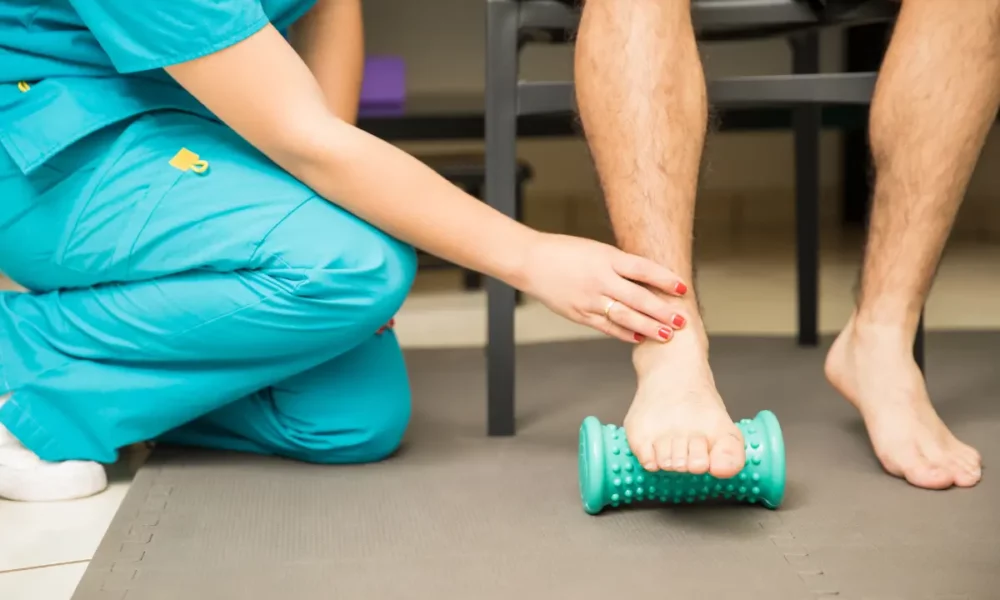5 Common Foot Problems and Their Solutions

Your feet can be subjected to up to 2.5 times your body weight in force with each step. Foot problems are understandable if they begin to manifest in your 50s after decades of wear and tear. The feet can be affected by various issues and illnesses, from inflammation to traumas. These consist of ingrown toenails, bunions, diabetic neuropathy, and athlete’s foot, among other conditions.
The foot is one of the most complex parts of the body, with 26 bones in each foot. Still, a person will walk an estimated 150,000 miles (about 241401.6 km) in their lifetime, which is nearly the same as walking around the world six times, according to studies.
Among the leading causes of foot issues include aging, diabetes, and improper footwear.
This post will discuss typical foot issues, their causes, and when to get medical attention.
1. Athlete’s foot
Walking in wet environments is the most common cause of athlete’s foot. It is contagious at times.
A fungal skin infection, athlete’s foot typically occurs in the space between the toes. However, the infection can spread and result in severe pain, itching, and discomfort.
Reasons
The most common places for a person to encounter the fungus that causes athlete’s foot are gyms, showers, and pools where people walk barefoot. Humidity and warmth are conducive to the growth of fungus.
Warm, moist shoes can encourage the growth and spread of the fungus. The disorder is highly contagious and can spread to the scalp, groin, and hands, among other parts of the skin.
Signs and symptoms
The feet become itchy, cracked, blistered, and peeled from the athlete’s foot. Usually, the illness begins in the space between the fourth and fifth toes and subsequently spreads. Additionally, a person may get cracks in their toes’ skin or heels.
Treatment
It is recommended that one keeps their feet clean and dry, using a different towel to dry them. Most drugstores include antifungal creams, sprays, or powders that can be applied to the feet. A person can consult ModPod Podiatry for the course of action. Speakingof, the prescription might include oral medications or therapy.
2. Bunions
Bunions may result from wearing shoes that are very thin or tight. Bunions are foot deformities that result in the development of a hump on the big toe joint. The big toe may bend slightly inward as a result of this. “Hallux valgus” is the medical term for bunions.
Bunions are more common in women because of the added pressure from small shoes.
Reasons
Bunions can occur when a person wears shoes that are too tight or thin. The metatarsophalangeal joint (MTP), which connects the bones of the foot and big toe, is compressed by tight shoes.
Another risk factor is the family history of bunions. In addition, polio and rheumatoid arthritis are two illnesses that raise the risk of getting a bunion.
Signs and symptoms
A person suffering from a bunion may exhibit one or more of the subsequent symptoms:
- noticeable lump on the foot’s side
- soreness on the big toe or in its vicinity
- corn or callus on the bone beneath the great toe
- having trouble extending the big toe
- walking-related big toe pain
Treatment
Most of the time, conservative treatment will reduce the bunion’s symptoms. One should wear shoes that fit well and don’t have excessive heels. Additionally, they can purchase a bunion pad at a pharmacy or shoe store to shield the bunion from additional strain.
Inflammation can also be decreased by applying cold water with an ice pack covered in cloth at 10-minute intervals.
A podiatrist, a medical professional focusing on foot care, can recommend splints or specially constructed shoe inserts to straighten the big toe. A person may decide to get surgery to fix their bunion if it does not go away and continues to cause them discomfort.
3. Diabetic nerve damage
Blood sugar swings are more common in those with diabetes. Diabetic neuropathy is a collection of disorders that result in diabetic foot injury rather than a single illness.
Reasons
Elevated blood sugar levels have the potential to cause nerve damage over time, particularly to the feet. A history of drunkenness, smoking, or a family history of diabetic neuropathy can all exacerbate this nerve damage.
Signs and symptoms
Diabetic neuropathy is characterized by tingling, numbness, and discomfort in the foot. This may increase the chance that someone will get cuts or other injuries to their feet due to losing feeling in them.
Treatment
Diabetic neuropathy can be treated by controlling blood sugar and maintaining excellent health. Although doctors cannot repair nerve damage, they can suggest therapies to prevent it from worsening.
Additionally, a diabetic patient needs to have regular foot checks. If they see foot wounds, they might want to file their toenails properly and contact a doctor.
4. Fibrous plantar edema
The bottom of your heel or the bottom of your middle foot may hurt if you have plantar fasciitis. This occurs when the plantar fascia ligament is strained by wearing soft-soled shoes with inadequate arch support, standing a lot, running long distances, gaining weight, or other foot issues.
The pain might be subtle or intense, and it can grow gradually. After extended rest, you could feel increased pain in your feet.
Treatment
Stretching the foot daily, using ice, and taking anti-inflammatory drugs are home remedies for the ailment. Your physician might be able to reduce discomfort with surgery, physical therapy, orthotics, or corticosteroid injections.
5. Bone foot inflammation
One form of painful foot bone inflammation is called sesamoiditis. Your foot’s sesamoids are the bones where tendons join to support the bending of your big toe.
When the sesamoids become damaged or inflamed, as happens frequently following specific sports like ballet or baseball catching, the condition known as sesamoiditis develops.
Treatment
Initial therapies for this illness may include resting your feet, applying heat or cold, taking pain medication, or attempting a compression bandage. Other therapies might also be necessary, as directed by your physician.
Ultimately!
Ultimately, the nature, signs, and severity of foot disorders can differ. If a foot ailment interferes with your daily activities or home remedies don’t work, you should consult a podiatrist for the correct diagnosis and treatment plan.





